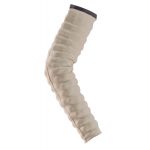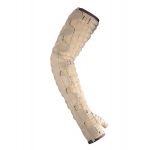Night Wear Compression Garments
Nighttime Lymphedema Garments, Compression Wraps, And Compression Sleeves
We have a large selection of compression garments, compression wraps, and compression sleeves that can be worn at night to help treat and manage lymphedema, edema, venous conditions, and other medical conditions.
••••••••••••••••••••Please note: With the passage of the Lymphedema Treatment Act (LTA), effective January 1, 2024, Medicare began to pay for lymphedema products for those who have Medicare B coverage and meet certain other coverage criteria. Please visit our website page covering the details of the Lymphedema Treatment Act to obtain more information about how Medicare pays for lymphedema garments, wraps, and bandages.
Medicare Pays For Lymphedema Products
Please note: Thanks to the Lymphedema Treatment Act, which took effect on January 1, 2024, Medicare began to pay for lymphedema products for those who have Medicare B coverage and meet certain other coverage criteria. Please visit our website page covering the details of the Lymphedema Treatment Act to obtain more information about how Medicare pays for lymphedema garments, wraps, and bandages.
Nighttime Lymphedema Garments, Compression Wraps, And Compression Sleeves
Most people experience fluctuations with swelling when they’re at rest. Compression garments, wraps, and sleeves that are designed for use during the day (when you’re up and active), can apply too much compression if you’re not moving. Compression garments, wraps, and sleeves that are specifically designed for use at night, however, provide a lower level of compression than daytime lymphedema products, which makes them more comfortable to wear.
But these nighttime garments, wraps, and sleeves are still doing their job while you sleep – preventing fluid from reaccumulating and preventing your limbs from swelling.
By wearing a nighttime compression garment, compression wrap, or compression sleeve, bandaging time can also be reduced. And it can be easier to apply your daytime lymphedema garments, wraps, and sleeves.
Nighttime Compression Garments For Lymphedema
Our selection of nighttime compression garments for lymphedema includes:
- arm compression garments (wrist to shoulder and fingers to shoulder)
- foot and ankle compression garments
- compression gloves
- compression gauntlets
- compression chin straps
- compression face masks (full masks and half-masks)
- compression neck masks
- compression eye pads
Nighttime Compression Wraps And Compression Sleeves For Lymphedema
Our selection of nighttime compression wraps and compression sleeves for lymphedema includes:
- full-length compression wrap arm sleeves (fingers to shoulder)
- lower leg compression wrap leg sleeves (toes to knee)
- thigh compression wrap leg sleeves (thigh only)
- full-length compression wrap leg sleeves (toes to top of thigh)
- mid-length compression wrap leg sleeves (toes to mid-thigh)
For more information about our nighttime lymphedema garments, compression wraps, and compression sleeves, please call (800) 700-1032, or e-mail: info@bandagesplus.com.
You may also consider our RianCorp laser for lymphedema treatment (post-mastectomy), as an additional treatment alternative.
••••••••••••••••••••••••••••••••••••FAQs About Nighttime Compression Garments For Lymphedema
Nighttime compression garments are specifically designed to manage lymphedema during sleep and non-active waking hours. Below are some of the most frequently asked questions about nighttime compression garments.
- What Are Nighttime Compression Garments
- Who Should Wear Nighttime Compression Garments
- Why Should I Wear Nighttime Compression Garments
- What Is The Difference Between Nighttime Compression Garments And Daytime Compression Garments
- Why Do I Need Less Compression At Night
- Are There Different Types Of Nighttime Compression Garments
- What Are The Levels Of Compression In Nighttime Garments
- 15-20 mmHg (mild compression)
- 20-30 mmHg (moderate compression)
- How Do I Know If My Nighttime Compression Garment Is Fitting Properly
- Can I Wear Nighttime Compression Garments During The Day
- How Often Should Nighttime Compression Garments Be Replaced
- Can Nighttime Compression Garments Be Washed
- Do I Need A Prescription To Get Nighttime Compression Garments
- Do Insurance Companies Cover Nighttime Compression Garments
- Does Medicare Cover Nighttime Compression Garments
Nighttime compression garments are garments that are designed to help encourage lymphatic fluid drainage while you sleep or are inactive.
Nighttime compression garments are designed for people who experience significant swelling and need continuous compression in order to help manage their lymphedema. Nighttime garments are also sometimes recommended for people to wear during the daytime, if they are fairly inactive and/or find standard compression garments too uncomfortable.
Check with your healthcare provider before you wear nighttime compression garments. In general, however, the point of wearing nighttime compression garments is to maintain limb volume and prevent lymph fluid from accumulating overnight. Nighttime compression garments might can lead to better sleep, if you have less swelling and are more comfortable.
At night, you want just the right amount of gentle, sustained compression to keep fluid from reaccumulating. Daytime compression garments, on the other hand, are meant to help actively reduce limb size, while you are active and moving around. Because of the different objectives, nighttime garments are usually less restrictive and made from softer, more breathable materials, while daytime garments tend to be more rigid.
When you sleep, you need less compression because there is naturally less fluid being pumped through your body. Therefore, less compression is needed to assist in lymphatic blood flow. Also, when you sleep, your body is usually in a horizontal position. This position reduces the effects of gravity on blood and lymphatic fluid circulation, compared to when you are upright. Therefore, the fluids do not need to be actively pushed upward against gravity, so you need less external compression. Finally, while you sleep or are inactive, your blood pressure tends to lower and your heart rate decreases. Excessive compression could interfere with those natural adjustments, potentially affecting the quality of your sleep and your overall circulatory health.
We have a large selection of nighttime compression garments and sleeves for just about every part of the body, including: legs, arms, hands, feet, wrists, neck, face, and eyes.
Nighttime garments are designed to complement daytime compression therapy, providing continuous lymphedema management without the intensity of daytime compression levels. Nighttime wear typically provides a lower level of compression than daytime garments, and the most common compression levels are:
Your nighttime compression garments should fit snugly, but not too tightly. You should be able to move freely without feeling restricted or experiencing pain. Your garment should cover the area of your body that is affected by lymphedema, including any areas that are prone to swelling. You should feel a gentle, even compression being applied throughout the garment, without any tight spots or loose areas. Your compression garment should stay in place throughout the night without shifting or sliding down, and there should not be any areas of pinching, bunching, or folding across the garment.
Your healthcare provider should make specific recommendations. In general, however, nighttime compression garments are designed to be worn while you sleep, because they provide a lower level of compression. This lower level of compression might not be sufficient for managing your lymphedema during the day, when you are more active and require a higher level of compression and support.
Generally, nighttime compression garments should be replaced every 3-6 months, because of stretching and the wear and tear from regular use.
You will need to follow the specific instructions from the manufacturer of your nighttime compression garments. In general, however, most nighttime compression garments can be washed in mild detergent, rinsed thoroughly, and air-dried. You should avoid fabric softeners and bleach, because they can degrade the material.
No. You can order all of our nighttime compression garments without a prescription.
Some insurance plans cover nighttime compression garments, with a prescription. Check with your insurance provider for specifics about your coverage.
Starting in January 2024, thanks to the Lymphedema Treatment Act, Medicare began covering compression products, including compression bandaging systems and supplies that are used during the initial decongestion phases and maintenance phases of lymphedema treatment. Click here to read more about the Lymphedema Treatment Act and how to order nighttime compression garments.
Please note that all of the information above is for general informational purposes. Please consult your healthcare provider for specific information and personalized recommendations for your situation.
For more information about our nighttime compression garments for lymphedema, please call (800) 700-1032, or e-mail info@bandagesplus.com



